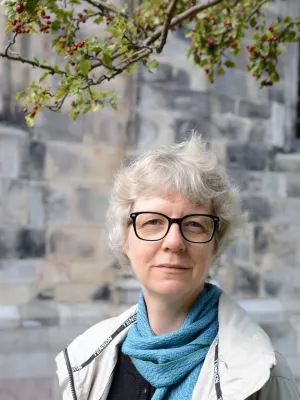
Sofia Feltzing
Professor of astronomy

From space to specs : Requirements for 4MOST
Author
Summary, in English
4MOST,1 the 4m Multi-Object spectrographic Survey Telescope, is an upcoming optical, fiber-fed, MOS facility for the VISTA telescope at ESO's Cero Paranal Observatory (Chile). The preliminary design of 4MOST features 2,400 fibers split into a low-resolution (1,600 fibers, 390-900 nm, R > 5; 000) and a high-resolution channel (800 fibers, three arms, ∼20-25 nm coverage each, R > 18; 000) with an Echidna-style positioner, and covering a hexagonal field of view of ∼4.1 sqdeg. 4MOST's main science goals encompass massive (tens of millions of spectra), all-Southern sky (> 18; 000 sqdeg) surveys following up both the Gaia (optical) and eROSITA (X-ray) space missions, plus cosmological science that complements missions such as e.g. Euclid. In a novel approach, observations of these science cases, which are very different from another, are to be carried out in parallel (i.e., simultaneously); thus, from the very different science requirements, key user requirements have to be identified, stringently formulated, and condensed into a coherent set of system specifications. Clearly, identifying common grounds and thereby significantly reducing complexity in both the formulated requirements and the final 4MOST facility, is a very challenging task. In this paper, we will present science and user requirements, and how the latter flow down from the former, and eventually further down to the system-specification level. Special emphasis will be put on the identification of key requirements and their validation and verification protocols, so that significant trade-offs can be done as early on in the design phase as possible, with as little impact as possible on the science capabilities upstream.
Department/s
- Lund Observatory - Has been reorganised
Publishing year
2014
Language
English
Publication/Series
Proceedings of SPIE - The International Society for Optical Engineering
Volume
9150
Document type
Conference paper
Publisher
SPIE
Topic
- Astronomy, Astrophysics and Cosmology
Keywords
- 4MOST
- ESO
- Requirements engineering
- Requirements management
- VISTA
Conference name
Modeling, Systems Engineering, and Project Management for Astronomy VI
Conference date
2014-06-22 - 2014-06-24
Conference place
Montreal, QC, Canada
Status
Published
ISBN/ISSN/Other
- ISSN: 1996-756X
- ISSN: 0277-786X
- ISBN: 9780819496188

